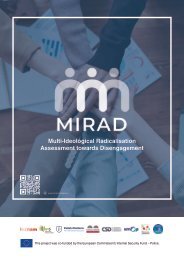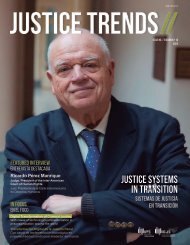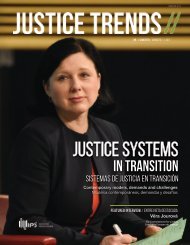Mental health, ageing and palliative care in prisons
Create successful ePaper yourself
Turn your PDF publications into a flip-book with our unique Google optimized e-Paper software.
Corrections<br />
Learn<strong>in</strong>g Academy<br />
<strong>Mental</strong> <strong>health</strong>, <strong>age<strong>in</strong>g</strong><br />
<strong>and</strong> <strong>palliative</strong> <strong>care</strong> <strong>in</strong> prison<br />
<strong>Mental</strong> <strong>health</strong><strong>care</strong>, suicide prevention, geriatrics, wellbe<strong>in</strong>g,<br />
<strong>and</strong> <strong>palliative</strong> <strong>care</strong> <strong>in</strong> prison<br />
Group <strong>and</strong> Tutored<br />
Prison Health
<strong>Mental</strong> <strong>health</strong>, <strong>age<strong>in</strong>g</strong> <strong>and</strong><br />
<strong>palliative</strong> <strong>care</strong> <strong>in</strong> <strong>prisons</strong><br />
About this course<br />
Group <strong>and</strong> Tutored<br />
This is a comprehensive tra<strong>in</strong><strong>in</strong>g course <strong>and</strong> programme that is divided <strong>in</strong>to three key areas of learn<strong>in</strong>g:<br />
mental <strong>health</strong><strong>care</strong> <strong>and</strong> suicide prevention, geriatrics, <strong>and</strong> <strong>palliative</strong> <strong>care</strong> <strong>in</strong> prison.<br />
This course meets the current <strong>and</strong> future needs of prison staff <strong>in</strong> the area of mental <strong>health</strong>, <strong>age<strong>in</strong>g</strong> <strong>and</strong><br />
<strong>palliative</strong> <strong>care</strong> for prisoners.<br />
calendar<br />
5h per week, for 6 weeks<br />
Who should attend?<br />
Pre-requisites<br />
chalkboa<br />
Blended learn<strong>in</strong>g:<br />
e-Learn<strong>in</strong>g, self-study<br />
<strong>and</strong> live onl<strong>in</strong>e sessions<br />
with a tra<strong>in</strong>er<br />
• Individuals <strong>and</strong>/or organisations that are<br />
responsible for prisoners<br />
• Professionals from entities l<strong>in</strong>ked with/or<br />
collaborat<strong>in</strong>g <strong>in</strong> <strong>in</strong>itiatives that promote the<br />
<strong>health</strong> of prisoners <strong>and</strong>/or prison staff<br />
check-sq Work<strong>in</strong>g <strong>in</strong> a prison service.<br />
check-sq A m<strong>in</strong>imum of 10 participants is required to<br />
start this course.<br />
We will make sure the groups are formed accord<strong>in</strong>gly once the 10<br />
enrolled tra<strong>in</strong>ees are reached.<br />
clock<br />
certific<br />
Total: 31h50<br />
16h e-Learn<strong>in</strong>g<br />
3h30 self-study<br />
12h live onl<strong>in</strong>e sessions<br />
with a tra<strong>in</strong>er (2 hours,<br />
after each module)<br />
Certificate of Completion<br />
The content of this course has been developed <strong>and</strong> piloted <strong>in</strong> Belgium, Portugal, Norway, Romania <strong>and</strong> The Netherl<strong>and</strong>s, under the MenACE project,<br />
co-funded by the European Commission under the ERASMUS + programme - KA2 - Strategic partnerships for adult education.<br />
The course content is free to access (except any modules with access restricted due to certification requirements). The price associated with this<br />
course refers to expert tutor<strong>in</strong>g <strong>and</strong> learn<strong>in</strong>g management system fees.
Welcome to your onl<strong>in</strong>e campus<br />
Corrections Learn<strong>in</strong>g Academy is an onl<strong>in</strong>e tra<strong>in</strong><strong>in</strong>g platform with real-time <strong>and</strong> self-paced programmes developed by Corrections experts.<br />
Here you can acquire relevant knowledge <strong>and</strong> develop new skills anytime, anywhere at your own pace.<br />
Our platform is powered by a sophisticated learn<strong>in</strong>g management system <strong>and</strong> complemented by our onl<strong>in</strong>e store so you can securely<br />
purchase as many courses as you’d like.<br />
Get promotional prices <strong>and</strong> exclusive access to course materials at:<br />
www.correctionslearn<strong>in</strong>g.onl<strong>in</strong>e<br />
Technical requirements<br />
Basic requirements<br />
To complete a programme, you’ll need a current email account <strong>and</strong> access to<br />
a computer <strong>and</strong> the <strong>in</strong>ternet, as well as a PDF Reader. You may need to view<br />
Microsoft PowerPo<strong>in</strong>t presentations <strong>and</strong> read <strong>and</strong> create documents <strong>in</strong> Microsoft<br />
Word or Excel.<br />
Browsers supported by Corrections Learn<strong>in</strong>g Academy<br />
Our learn<strong>in</strong>g platform is compatible with all modern browsers, <strong>in</strong>clud<strong>in</strong>g Firefox,<br />
IE 9+, Chrome, Safari, <strong>and</strong> Opera. The platform is also compatible with all browsers<br />
used by the latest mobile devices (i.e., iOS <strong>and</strong> Android). We recommend you to<br />
use a modern browser to experience our platform the best way possible.
Contents<br />
Orientation module<br />
You’ll be welcomed with a live session <strong>and</strong> technical support<br />
network. You will then beg<strong>in</strong> connect<strong>in</strong>g with fellow participants<br />
while explor<strong>in</strong>g the tools of Corrections Learn<strong>in</strong>g. Moreover, you<br />
will be alerted to key milestones <strong>in</strong> the learn<strong>in</strong>g path, <strong>and</strong> be able to<br />
review how your results will be calculated <strong>and</strong> distributed.<br />
You’ll be required to complete your participant profile <strong>and</strong> submit a<br />
digital copy of your passport/identity document.<br />
The Essentials of Prison Health<br />
• Introduction: “Prison <strong>health</strong> is public <strong>health</strong>”<br />
Pr<strong>in</strong>ciples <strong>and</strong> st<strong>and</strong>ards <strong>in</strong> prison <strong>health</strong><br />
• Key pr<strong>in</strong>ciples<br />
• Inmates’ rights to <strong>health</strong> <strong>care</strong> practices<br />
• The prisoner as a patient<br />
• The organisation of prison <strong>health</strong> <strong>care</strong><br />
• St<strong>and</strong>ardised prison <strong>health</strong> <strong>care</strong> duties<br />
Communicable diseases<br />
• The burden of disease <strong>and</strong> transmission factors <strong>in</strong> prison<br />
• Bloodborne diseases (e.g., HIV; HpB, HPC)<br />
• Tuberculosis<br />
• Sexually transmitted <strong>in</strong>fections<br />
• Sk<strong>in</strong> conditions<br />
• Infectious diseases of the digestive tract<br />
Non-communicable diseases (cardiovascular diseases, cancers,<br />
respiratory diseases, mental disorders, neurological disorders,<br />
endocr<strong>in</strong>ological disorders)<br />
• The burden of disease <strong>and</strong> risk factors for NCDs <strong>in</strong> <strong>in</strong>mates<br />
• Challenges <strong>in</strong> provid<strong>in</strong>g appropriate prevention<br />
• Implement<strong>in</strong>g appropriate <strong>care</strong> <strong>and</strong> treatment st<strong>and</strong>ards<br />
<strong>Mental</strong> <strong>health</strong><br />
• Concepts <strong>and</strong> term<strong>in</strong>ology / what is mental illness?<br />
• Prevalence of poor mental <strong>health</strong> <strong>and</strong> illness <strong>in</strong> <strong>prisons</strong><br />
• The impact of imprisonment on mental <strong>health</strong><br />
Oral <strong>health</strong><br />
• The general impact of general <strong>health</strong> on oral <strong>health</strong><br />
• Oral <strong>health</strong> promotion
Contents<br />
Drug use <strong>and</strong> drug services <strong>in</strong> prison<br />
• Prevalence of drug use, <strong>and</strong> related risks<br />
• Prevention, treatment, harm reduction <strong>and</strong> after<strong>care</strong><br />
Prisoners with special needs<br />
• Prisoners with physical disabilities<br />
• Ethnic m<strong>in</strong>orities <strong>and</strong> <strong>in</strong>digenous peoples<br />
• Foreign prisoners<br />
• Lesbian, gay, bisexual, <strong>and</strong> transgender prisoners<br />
• Older prisoners<br />
Women’s <strong>health</strong> <strong>in</strong> prison<br />
• Facts <strong>and</strong> figures<br />
• Gender-specific <strong>health</strong> <strong>care</strong><br />
• Pregnancy<br />
• Children<br />
The older prisoner<br />
• Accelerated <strong>age<strong>in</strong>g</strong><br />
• Geriatric medic<strong>in</strong>e<br />
• Age<strong>in</strong>g <strong>and</strong> re-entry <strong>in</strong>to the community<br />
• Palliative <strong>care</strong><br />
<strong>Mental</strong> <strong>health</strong> <strong>in</strong> <strong>prisons</strong><br />
Introduction<br />
• Concepts <strong>and</strong> term<strong>in</strong>ology / what is mental illness? The three groups<br />
of mental disorders (neuroses, psychoses, <strong>and</strong> personality disorders)<br />
• Prevalence of poor mental <strong>health</strong> <strong>and</strong> illness <strong>in</strong> <strong>prisons</strong><br />
• The impact of imprisonment on mental <strong>health</strong><br />
Special needs <strong>and</strong> challenges<br />
• Access to justice<br />
• Prison environment<br />
• Health <strong>care</strong><br />
• Discrim<strong>in</strong>ation <strong>and</strong> stigmatisation<br />
• Safety <strong>and</strong> security risks<br />
• Suicide <strong>and</strong> self-harm<br />
• Preparation for release <strong>and</strong> post-release support<br />
Support<strong>in</strong>g mental <strong>health</strong> <strong>and</strong> wellbe<strong>in</strong>g <strong>in</strong> <strong>prisons</strong><br />
• Levels of <strong>care</strong><br />
• Cl<strong>in</strong>ical <strong>health</strong><strong>care</strong> services<br />
• Transfer to specialised units<br />
• Non-cl<strong>in</strong>ical mental <strong>health</strong> services<br />
• <strong>Mental</strong> <strong>health</strong> promotion checklist
Contents<br />
Suicide <strong>and</strong> self-harm prevention<br />
• Introduction<br />
• Suicide profiles<br />
• Suicide risk factors<br />
• Key components of a suicide prevention programme<br />
• Respond<strong>in</strong>g to suicide (attempts)<br />
<strong>Mental</strong> <strong>health</strong> needs of young offenders<br />
• Facts <strong>and</strong> figures<br />
• Specific mental <strong>health</strong> needs<br />
• Increas<strong>in</strong>g young offenders’ mental wellbe<strong>in</strong>g (treatment models)<br />
• Liaison <strong>and</strong> diversion<br />
<strong>Mental</strong> <strong>health</strong> needs of women <strong>in</strong> prison<br />
• Facts <strong>and</strong> figures<br />
• Specific mental <strong>health</strong> needs<br />
• Responses & <strong>in</strong>terventions<br />
Identify<strong>in</strong>g mental <strong>health</strong> problems <strong>in</strong> <strong>prisons</strong>: signs <strong>and</strong><br />
procedures<br />
• ‘What to look for?’: Symptoms/signs to identify mental <strong>health</strong><br />
problems among prisoners<br />
• Common mental <strong>health</strong> problems <strong>in</strong> prison <strong>and</strong> its ma<strong>in</strong> symptoms<br />
• Risk factors/red flags<br />
• Actions <strong>and</strong> procedures: <strong>in</strong>itial screen<strong>in</strong>g <strong>and</strong> assessment, mental<br />
<strong>health</strong> referral procedures, multidiscipl<strong>in</strong>ary teamwork <strong>and</strong> positive<br />
communication<br />
Ensur<strong>in</strong>g cont<strong>in</strong>uity of <strong>care</strong><br />
• Introduction<br />
• Cont<strong>in</strong>uity between prison <strong>and</strong> the community<br />
• Cont<strong>in</strong>uity between <strong>prisons</strong><br />
Geriatrics <strong>in</strong> prison<br />
Holistic <strong>care</strong> for the older prisoner<br />
• Concepts <strong>and</strong> term<strong>in</strong>ology<br />
• A rapidly grey<strong>in</strong>g prison population: facts <strong>and</strong> figures<br />
• Recurrent <strong>health</strong> issues among elderly <strong>in</strong>mates<br />
• The high costs of <strong>in</strong>carcerat<strong>in</strong>g the elderly<br />
• Human rights considerations<br />
Special needs <strong>and</strong> challenges<br />
• Access to justice<br />
• Assessment<br />
• Accommodation<br />
• Health <strong>care</strong><br />
• Family l<strong>in</strong>ks
Contents<br />
Inmate programmes<br />
• Preparation for release <strong>and</strong> post-release support<br />
• Early conditional release, compassionate release <strong>and</strong> amnesties<br />
Identify<strong>in</strong>g age-related issues <strong>in</strong> prison: signs <strong>and</strong> procedures<br />
• Physical difficulties (such as impaired hear<strong>in</strong>g <strong>and</strong> vision <strong>and</strong><br />
decreased mobility)<br />
• Geriatric syndromes<br />
• Long-term abuse of substances<br />
• Needs <strong>and</strong> obstacles<br />
• Palliative <strong>and</strong> hospice <strong>care</strong> services <strong>and</strong> <strong>care</strong> models <strong>in</strong> prison<br />
Communication <strong>and</strong> teamwork<br />
• Basic communication concepts<br />
• Interdiscipl<strong>in</strong>ary team <strong>in</strong> <strong>palliative</strong> <strong>care</strong> <strong>and</strong> their roles<br />
• Communication with patients/ families <strong>and</strong> between <strong>care</strong> team<br />
members<br />
• Conflict management<br />
Work<strong>in</strong>g with older prisoners: good practice<br />
• Age-friendly reception <strong>and</strong> <strong>in</strong>duction<br />
• Older prisoner forums<br />
• Day centre <strong>and</strong> day services provision<br />
• Older prisoner policy<br />
Ensur<strong>in</strong>g cont<strong>in</strong>uity of <strong>care</strong><br />
• Cont<strong>in</strong>uity between <strong>prisons</strong><br />
• Cont<strong>in</strong>uity between prison <strong>and</strong> the community<br />
Palliative Care <strong>in</strong> Prison<br />
Palliative <strong>care</strong>: Introduction<br />
• Concepts <strong>and</strong> term<strong>in</strong>ology: What is <strong>palliative</strong> <strong>care</strong> <strong>and</strong> hospice <strong>care</strong>?<br />
Underst<strong>and</strong><strong>in</strong>g the concept of “total pa<strong>in</strong>”<br />
• Facts <strong>and</strong> figures<br />
Patients’ needs<br />
• Pa<strong>in</strong>, screen<strong>in</strong>g tools <strong>and</strong> <strong>palliative</strong> <strong>care</strong> needs<br />
• Patients’ quality of life <strong>and</strong> monitor<strong>in</strong>g<br />
First aid <strong>in</strong> <strong>palliative</strong> <strong>care</strong><br />
• Emergencies, <strong>care</strong> <strong>and</strong> report<strong>in</strong>g <strong>in</strong>terventions<br />
Term<strong>in</strong>al stage<br />
• Signs of term<strong>in</strong>al stage<br />
• Needs identification <strong>and</strong> <strong>in</strong>terventions<br />
Ensur<strong>in</strong>g cont<strong>in</strong>uity of <strong>care</strong><br />
• Cont<strong>in</strong>uity of <strong>care</strong> with<strong>in</strong> <strong>palliative</strong> <strong>care</strong><br />
• Cont<strong>in</strong>uity of <strong>care</strong> between <strong>prisons</strong>
Contents<br />
Staff <strong>health</strong> <strong>and</strong> wellbe<strong>in</strong>g <strong>in</strong> <strong>prisons</strong><br />
Dynamic security<br />
Introduction<br />
• Staff <strong>and</strong> the prison environment<br />
• Prison staff challenges<br />
The stressful workplace<br />
• Work stress & burnout<br />
• Job stress among prison staff<br />
Health promotion <strong>and</strong> awareness<br />
• The whole-prison approach<br />
• Health promotion programmes for staff<br />
• Health awareness <strong>and</strong> staff tra<strong>in</strong><strong>in</strong>g<br />
Introduction<br />
• The essentials of dynamic security<br />
Elements of dynamic security<br />
• Professional <strong>and</strong> constructive relationships with prisoners<br />
• Interpersonal skills<br />
• Staff selection <strong>and</strong> tra<strong>in</strong><strong>in</strong>g<br />
• Embedd<strong>in</strong>g dynamic security <strong>in</strong> operational policy<br />
• Unit management <strong>and</strong> direct supervision<br />
• Gather<strong>in</strong>g <strong>in</strong>formation<br />
• Prevention of staff corruption <strong>and</strong> manipulation<br />
• Constructive activities for prisoners<br />
Staff support<br />
• Introduction<br />
• Peer support programmes<br />
• Physical <strong>health</strong> & staff tra<strong>in</strong><strong>in</strong>g<br />
• Family support & therapeutic <strong>in</strong>terventions<br />
• Recommended practices for staff support<br />
Intelligence <strong>and</strong> dynamic security<br />
• Intelligence <strong>and</strong> dynamic security as two complementary <strong>and</strong><br />
<strong>in</strong>tertw<strong>in</strong>ed concepts<br />
Apply<strong>in</strong>g dynamic security concepts to <strong>health</strong><strong>care</strong> <strong>in</strong> <strong>prisons</strong><br />
• Dynamic security <strong>and</strong> <strong>health</strong> promotion
After complet<strong>in</strong>g the<br />
course, tra<strong>in</strong>ees will<br />
receive a Certificate as<br />
proof of their learn<strong>in</strong>g<br />
activities at the onl<strong>in</strong>e<br />
Corrections Learn<strong>in</strong>g<br />
Academy.
Who you’ll learn from<br />
Ângela Fern<strong>and</strong>es is a psychotherapist <strong>and</strong> a forensic expert. She holds a<br />
master’s degree <strong>in</strong> Psychology <strong>and</strong> a PhD <strong>in</strong> Applied Psychology from the<br />
University of M<strong>in</strong>ho, Portugal. Ângela is a Consultant <strong>and</strong> Senior Researcher<br />
at IPS Innovative Prison Systems <strong>and</strong> collaborates <strong>in</strong> Rehabilitation <strong>and</strong><br />
Re<strong>in</strong>tegration projects.<br />
Ângela Fern<strong>and</strong>es<br />
Consultant @IPS<br />
Vítor Costa holds a PhD <strong>in</strong> Psychology <strong>and</strong> is a professor at the University<br />
of Beira Interior <strong>and</strong> researcher at the BSAFE Law Enforcement, Justice <strong>and</strong><br />
Public Safety Lab. Vítor is one of the authors of the RRAP Radicalisation<br />
Risk Assessment <strong>in</strong> Prisons toolset.<br />
Vítor Costa<br />
Researcher @UBI
Academy board<br />
Pedro das Neves<br />
Chief Executive Officer @IPS<br />
CEO of IPS Innovative Prison Systems <strong>and</strong> ICJS<br />
Innovative Crim<strong>in</strong>al Justice Systems Inc., Board<br />
Director of ICPA, the International Prisons <strong>and</strong><br />
Corrections Association, <strong>and</strong> the BSAFE Law<br />
Enforcement - Justice <strong>and</strong> Public Safety Lab. Pedro<br />
holds a Sociology degree <strong>and</strong> an M.A. <strong>and</strong> other<br />
learn<strong>in</strong>g experiences <strong>in</strong> universities worldwide.<br />
He worked on crim<strong>in</strong>al justice reform for 20<br />
years <strong>and</strong> has been <strong>in</strong>volved <strong>in</strong> design<strong>in</strong>g <strong>and</strong><br />
implement<strong>in</strong>g <strong>in</strong>novative projects awarded as<br />
best practices. He is the founder/editor of JUSTICE<br />
TRENDS magaz<strong>in</strong>e <strong>and</strong> was recognised with the<br />
ICPA Correctional Excellence Award (Management<br />
& Staff Tra<strong>in</strong><strong>in</strong>g). Pedro das Neves is a lecturer<br />
on the UNED (Spa<strong>in</strong>) post-graduate programme<br />
“Master on Penitentiary Management, Intervention<br />
<strong>and</strong> Adm<strong>in</strong>istration” <strong>and</strong> an appo<strong>in</strong>ted member<br />
of the European Commission (‘DG JUST’) group of<br />
experts on European Judicial Tra<strong>in</strong><strong>in</strong>g.<br />
Ana Maria Evans<br />
Chief Innovation Officer @IPS<br />
Ana Maria Evans is Chief Innovation Officer at IPS<br />
Innovative Prison Systems <strong>and</strong> an Invited Professor<br />
<strong>in</strong> the “Philosophy, Politics <strong>and</strong> Economics”<br />
(PPE) programme of the Portuguese Catholic<br />
University. Ana holds a Law degree (Catholic<br />
University, Lisbon), a M.A. <strong>in</strong> International Relations<br />
(University of San Diego), <strong>and</strong> a PhD <strong>in</strong> Government<br />
(Georgetown University). Ana taught <strong>and</strong> developed<br />
research <strong>in</strong> the U.S <strong>and</strong> Portuguese universities,<br />
published scientific articles <strong>in</strong> <strong>in</strong>ternational<br />
journals <strong>and</strong> books, delivered work <strong>in</strong> <strong>in</strong>ternational<br />
conferences, served as a committee member to<br />
<strong>in</strong>ternational meet<strong>in</strong>gs, won <strong>and</strong> coord<strong>in</strong>ated an<br />
FCT Start<strong>in</strong>g Grant for research on “Governance<br />
Models <strong>and</strong> the Delivery of Public Services”. Ana<br />
has been the recipient of <strong>in</strong>ternational fellowships/<br />
grants <strong>and</strong> has served on the board of civil society<br />
organizations, <strong>in</strong>clud<strong>in</strong>g the Fulbright Alumni<br />
Association - Portugal.<br />
Ioan Durnescu<br />
Professor @University of Bucharest<br />
Prof. Dr. Ioan Durnescu is a Professor at the<br />
University of Bucharest, Faculty of Sociology<br />
<strong>and</strong> Social Work. He teaches <strong>and</strong> researches <strong>in</strong><br />
the field of Corrections, with a special <strong>in</strong>terest<br />
<strong>in</strong> work<strong>in</strong>g methodologies <strong>and</strong> comparative<br />
probation. He is one of the editors of the Probation<br />
<strong>in</strong> Europe (WOLF) <strong>and</strong> the Underst<strong>and</strong><strong>in</strong>g Penal<br />
Practice (Routledge) <strong>and</strong> the co-editor of the<br />
European Journal of Probation, published by the<br />
University of Bucharest <strong>in</strong> partnership with SAGE<br />
Publish<strong>in</strong>g. Dr. Ioan is an honorary member of<br />
the Confederation of European Probation (CEP),<br />
Vice-President of the Collegium of Social Workers<br />
of Romania <strong>and</strong> a former chair of the Community<br />
Sanctions <strong>and</strong> Measures Work<strong>in</strong>g group with<strong>in</strong><br />
the European Society of Crim<strong>in</strong>ology. He is the<br />
author of the book “Core Correctional Skills”, a<br />
result of many years of teach<strong>in</strong>g <strong>and</strong> tra<strong>in</strong><strong>in</strong>g<br />
prison <strong>and</strong> probation staff worldwide.
Corrections<br />
Learn<strong>in</strong>g Academy<br />
laptop www.correctionslearn<strong>in</strong>g.onl<strong>in</strong>e<br />
keyboard <strong>in</strong>fo@correctionslearn<strong>in</strong>g.onl<strong>in</strong>e<br />
Copyright © 2021 IPS_Innovative Prison Systems

















